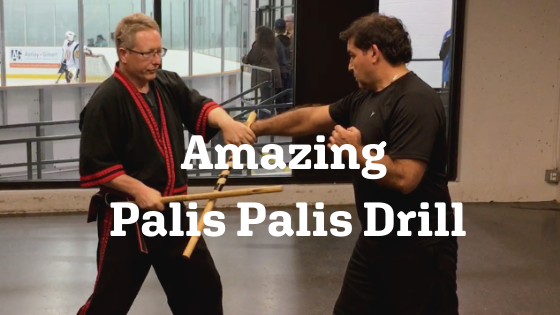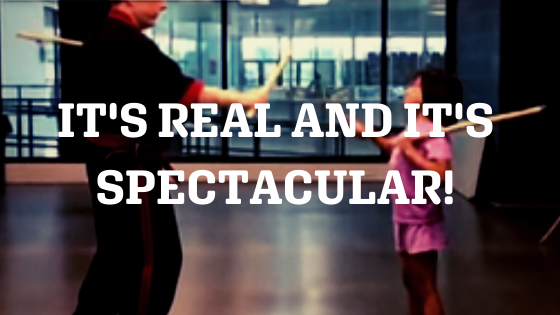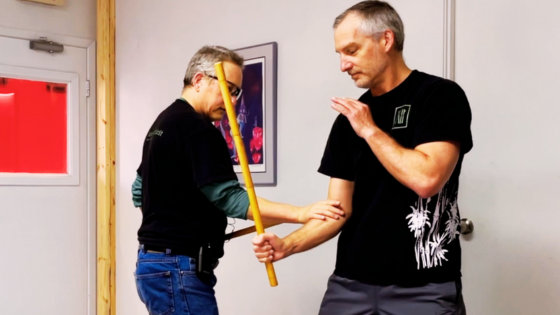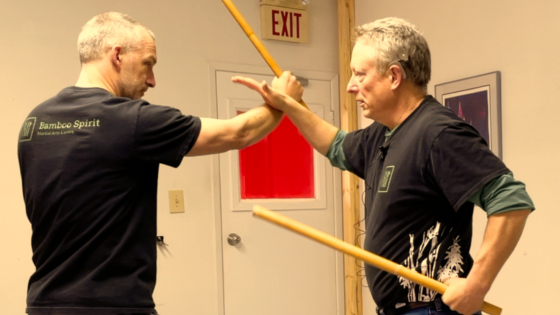Amazing Palis Palis Drill!
Estimated reading time: 3 minutes
Let’s face it. Drills are a heck of a lot of fun!
In my opinion, flow drills are a step up from the one-step method. Don’t get me wrong, the one-step method is a great way to learn the building blocks of a martial art. Once you have the foundation of a concept, we can build on the conceptual skill set through flow drills.
Now, the topic of this post is palis palis.
First, what is “palis palis?” It means to sweep or brush away the opponent’s force. To do this, I redirect the opponent’s energy both with my stick and my check hand.

Notice how I swept Alex’s stick to the other side? This is not a force-on-force technique. Rather, I am redirecting his force to end up on his outside line, from which I can execute various techniques.
This is an excellent example of a one-step technique. Many of us have done this technique against angle 1 as well as angle 2.
Here’s what the angle 2 version of palis palis looks like.

Again, note how I redirected Alex’s force to put me in a positional advantage.
But how many of us have gone beyond the one-step version to combining angles 1 and 2 into a drill?
Fast forward to the 0:56 mark of the video below to see what I mean.
If you are not able to view the video, click here.
What is the purpose of this drill?
“What if you lose control of the angle 1 palis palis technique? And the training partner pulls away and winds up for an angle 2 attack?”
Well, you better be ready for the angle 2 attack.
Not everyone will comply with your angle 1 technique. If I felt someone attempting palis palis on me, I would immediately counter by pulling my cane out of my training partner’s check hand grip.
Therefore, it would behoove you to have a backup plan if your training partner counters you in this manner.
Hence, the reason for the above drill. Besides, it’s a lot of fun and keeps you on your toes!
Shhhhh, I have a tip to prevent your training partner from countering you: as soon as you do the angle 1 palis palis, immediately do the #5 thrust to his abdomen.
This may prevent your training partner from countering your palis palis and executing the angle 2 follow-up attack. Always keep them busy by being proactive!
And for those wondering how this concept translates to empty hands, see this brief clip. To view the entire video, go here.

To read more on translating weapons movements to empty hands, go here.
In summary, palis palis is a means of redirecting your training partner’s energy or force so that you position yourself in a favorable zone.
This concept is easy to learn but difficult to master. I’m not yet satisfied with my palis palis execution compared to how Professor Presas was doing it shortly before his passing. Man, talk about beauty and efficiency!
It is one of the significant parts of Modern Arnis but the most challenging to perfect. Practice palis palis as much as you can!
Additional Reading
- Low High Palis Palis
- Which Technique Is Best?
- Review of Master Chuck’s “Combat 2 vs. 1 ” DVD
- 3 Great Reasons For One Step Sparring
- 5 Problems With One Step Sparring
Share this post:
- Click to share on Twitter (Opens in new window)
- Click to share on Facebook (Opens in new window)
- Click to share on LinkedIn (Opens in new window)
- Click to share on WhatsApp (Opens in new window)
- Click to share on Nextdoor (Opens in new window)
- Click to share on Pinterest (Opens in new window)
- Click to email a link to a friend (Opens in new window)
Tags In
Brian Johns
Related Posts
4 Comments
Leave a Reply Cancel reply
Categories
- Arnis/Kali/Eskrima (113)
- Book Review (8)
- DVD Reviews (3)
- Guest Post (4)
- Inspiration (24)
- Martial Arts (99)
- My story (92)
- Safety (14)
- Tips & tricks (6)
- Uncategorized (3)
- YouTube Videos (8)






[…] “Amazing Palis Palis Drill” post showcased a simple drill against angles 1 and […]
[…] of the above (abanico corto, high palis palis, and the standard palis palis) are all premised on redirecting the stick or the weapon […]
[…] Amazing Palis Palis Drill! […]
[…] Amazing Palis Palis Drill! […]